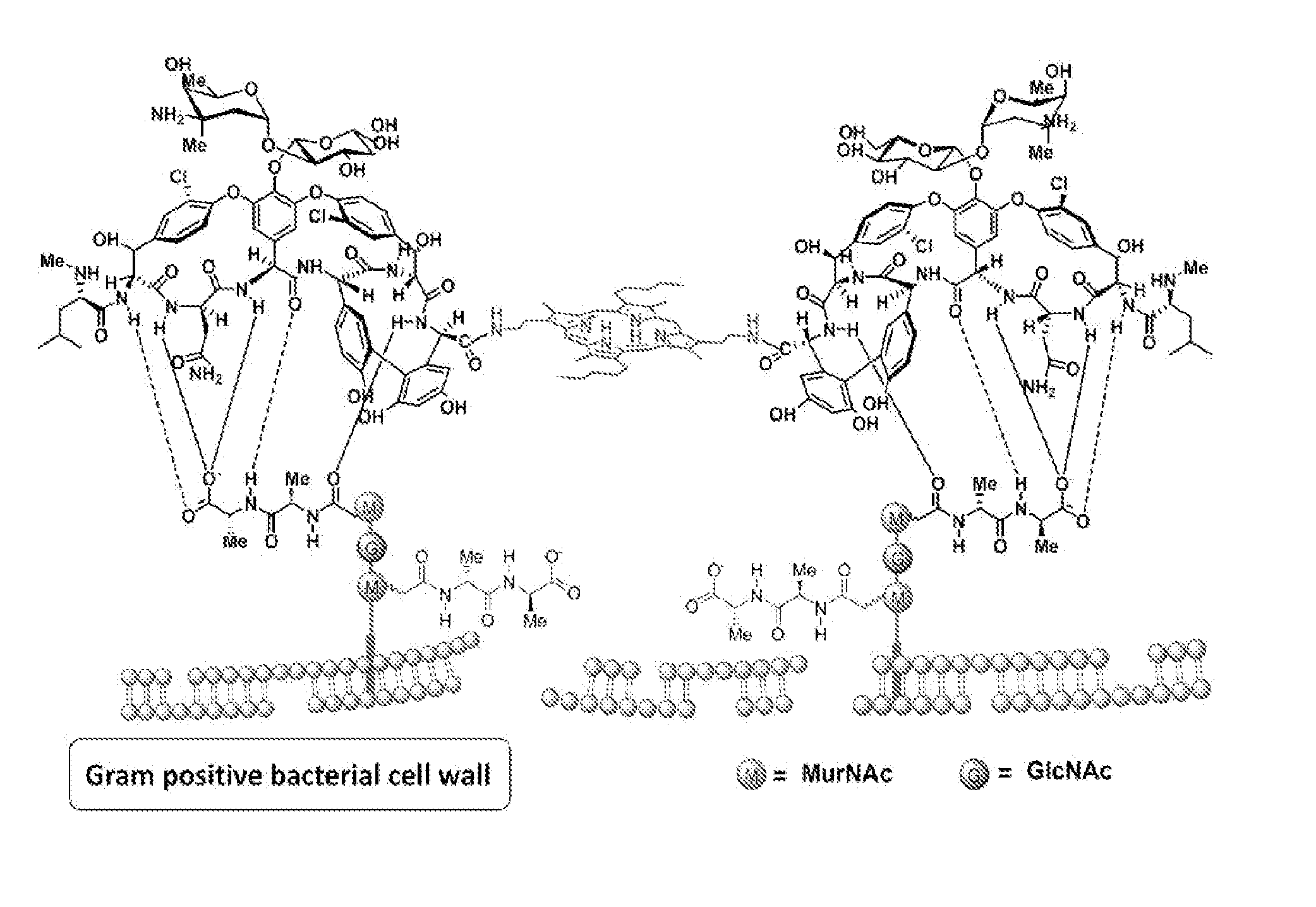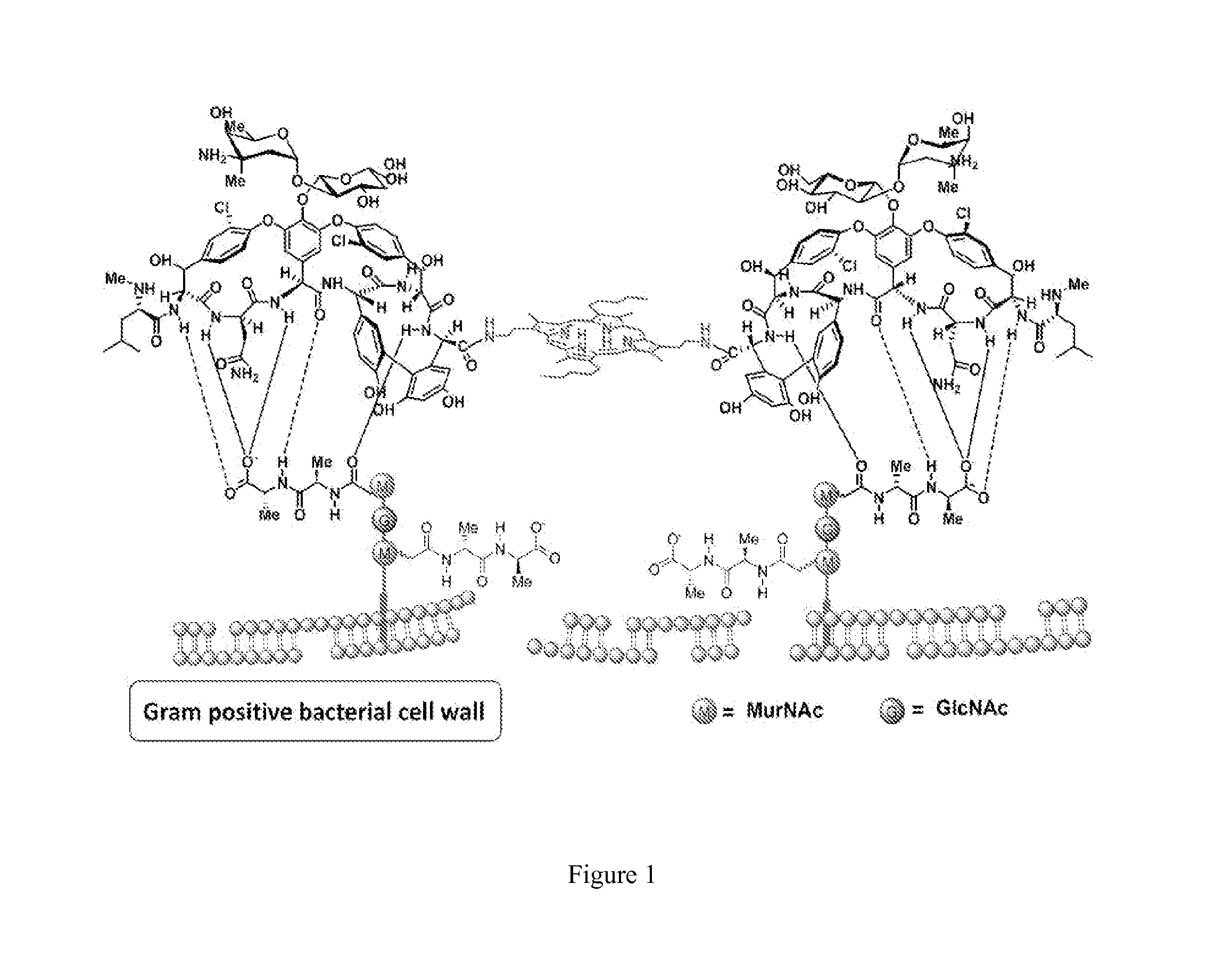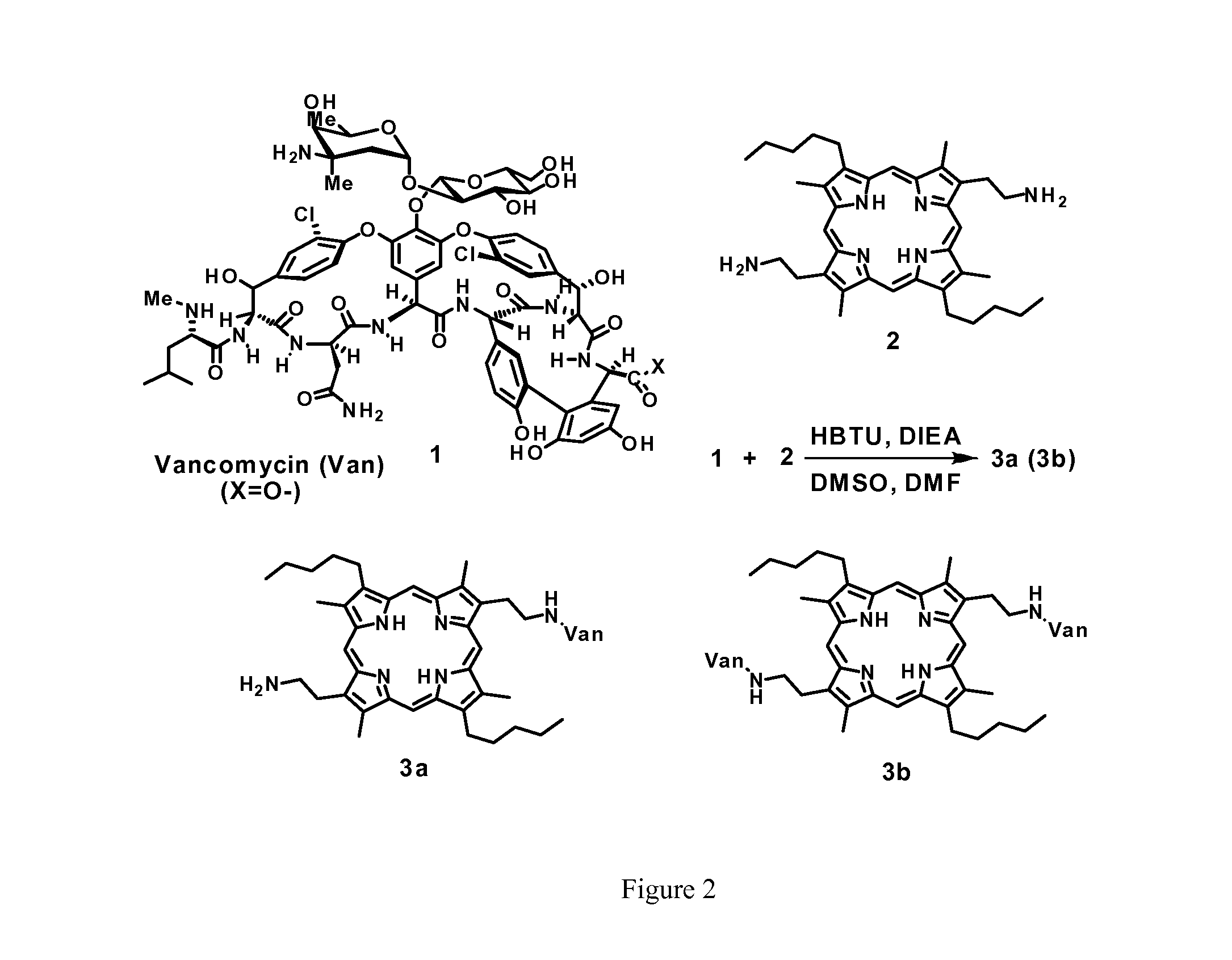Multifunctional glycopeptide antibiotic derivatives for fluorescent imaging and photoactive antimicrobial therapy
a glycopeptide and fluorescent imaging technology, applied in the direction of cyclic peptide ingredients, pharmaceutical non-active ingredients, saccharide peptide ingredients, etc., can solve the problems of substantial decrease of binding affinity, serious threat to public health, and drawbacks of these affinity groups to target the bacterial surfa
- Summary
- Abstract
- Description
- Claims
- Application Information
AI Technical Summary
Benefits of technology
Problems solved by technology
Method used
Image
Examples
example 1
[0126]Synthesis of monovalent Van-porphyrin 3a (compound of formula III): Vancomycin hydrochloride (52.8 mg, 35.9 μmol, 1.04 equiv.) and porphyrin 2 (20.8 mg, 35.1 μmol, 1.00 equiv.)[15] were dissolved in 2 mL of dry dimethyl sulfoxide (DMSO). The mixture was cooled to 0° C., and O-benzotriazol-1-yl-N,N,N′,N′ tetramethyluronium hexafluorophosphate (HBTU) (38.0 mg, 100.2 μmol, 2.85 equiv.) in 1 mL of dry N,N-dimethylformamide (DMF) was added, followed by N,N-diisopropylethylamine (DIEA) (0.06 mL, 344 μmol, 9.8 equiv.). The mixture was allowed to rise to room temperature and stirred overnight. The reaction was quenched by adding dropwise 20 mL of acetone. A deep purple solid was precipitated, filtered out and was washed once by 5 mL of acetone. The crude product was purified by reversed-phase HPLC (RP-HPLC) to give 37.4 mg (18.5 μmol) of pure product (yield: 52.9%). 1H-NMR (300 MHz, DMSO-d6): 10.28 (br s), 10.22 (s), 10.27 (s), 9.43 (br s), 9.12(br s), 8.68 (br s), 8.60 (br s), 8.18 (...
example 2
[0127]Synthesis of divalent Van-porphyrin 3b (compound of formula II): Vancomycin hydrochloride (106.5 mg, 71.7 μmol, 2.04 equiv.) and 2 (20.8 mg, 35.1 μmol, 1.00 equiv.) were dissolved in 2 mL of dry dimethyl sulfoxide (DMSO). The mixture was cooled to 0° C., and O-benzotriazol-1-yl-N,N,N,N′ tetramethyluronium hexafluorophosphate (HBTU) (38.0 mg, 100.2 μmol, 2.85 equiv.) in 1 mL of dry N,N-dimethylformamide (DMF) was added, followed by N,N-diisopropylethylamine (DIEA) (0.06 mL, 344 μmol, 9.8 equiv.). The mixture was allowed to rise to room temperature and stirred overnight. The reaction was quenched by adding dropwise 20 mL of acetone. A deep purple solid was precipitated, filtered out and was washed once by 5 mL of acetone. The crude product was purified by reversed-phase HPLC (RP-HPLC) to give 64.9 mg (18.8 μmol) of pure product (yield: 53.6%). 1H-NMR (300 MHz, DMSO-d6): 8.98 (br s), 8.69 (br s), 7.94 (s), 7.67 (br s), 7.54 (br, s), 7.28 (d, 8.4 Hz), 6.92 (d, 8.0 Hz), 6.80 (d, 8....
example 3
[0128]In order to ascertain that the porphyrin is covalently bonded to Van, both 3a and 3b were effectively separated by reverse-phase HPLC and both molecules show characteristic retention times. On the other hand, a mixture consisting of porphyrin and Van shows only the retention times of the individual species. This result rules out the possibility of non-covalent adduct formation between Van and porphyrin. In addition, the MALDI-ToF-MS results clearly yield the precise mass of 3a and 3b, indicating the formation of covalently Van bonded Van and porphyrin moiety.
PUM
| Property | Measurement | Unit |
|---|---|---|
| Wavelength | aaaaa | aaaaa |
| Wavelength | aaaaa | aaaaa |
| Pharmaceutically acceptable | aaaaa | aaaaa |
Abstract
Description
Claims
Application Information
 Login to View More
Login to View More - R&D
- Intellectual Property
- Life Sciences
- Materials
- Tech Scout
- Unparalleled Data Quality
- Higher Quality Content
- 60% Fewer Hallucinations
Browse by: Latest US Patents, China's latest patents, Technical Efficacy Thesaurus, Application Domain, Technology Topic, Popular Technical Reports.
© 2025 PatSnap. All rights reserved.Legal|Privacy policy|Modern Slavery Act Transparency Statement|Sitemap|About US| Contact US: help@patsnap.com



